Onions
BackOnions are a popular edible bulb grown for their distinctive flavour and used in just about every type of cuisine around world. Brown onions have the strongest flavour and are perfect for stews and casseroles while white onions are softer in flavour but still used mostly in cooked dishes. Red onions are the mildest with a slightly sweet flavour and are commonly eaten fresh in sandwiches and salads.
Onions are generally grown anytime from autumn to spring but ultimate success lies in choosing the right variety for your climate and growing it at the right time.
Choosing Onion Varieties
While there are many different onion varieties they can generally be grouped according the amount of daylight hours they require to develop a bulb:
- Early season or short day varieties – need the shortest amount of daylight hours (around 10-11 hours)
- Mid season or intermediate varieties – need a middle amount of daylight hours
- Late season or long day varieties – need the longest of daylight hours (around 15-16 hours)
- Neutral varieties – a small number of varieties are not impacted by day length
Early season varieties will be the quickest to harvest but tend to not store for that long. Conversely late season varieties usually take the longest to reach maturity but the resulting bulb have the best storage life.
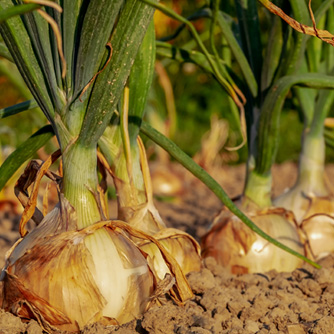
Onions nearly ready for harvesting
If you live in southern Australia you can grow any type of onion as there are distinct differences in the length of daylight hours between the seasons. In northern Australia the daylight hours don’t change as much so the early season varieties are the best performers.
While this can be a bit confusing the good news is that most seed packets will indicate if it’s an early, mid or late season onion. Use this information plus the recommended sowing times for your region to help you get the best results.
How To Grow Onions
Onions will do best in a sunny spot and in soil that has been enriched with a little compost and aged manures. Always apply these a few weeks before sowing or planting as fresh organic matter may cause rotting, poor bulb formation or attract onion flies. Soil should be slightly slightly acidic (6.5 pH) so apply lime or dolomite if your soil it below that.
With onions it’s very important to practise crop rotation to minimise pest and disease issues. Do not grow onions in the same part of the vegie patch every year.
Onion seed can be sown in punnets or directly into the soil. Cover lightly and water in with OCP eco-seaweed to encourage germination. Seedlings take 4 to 14 day to emerge depending on the soil temperature (even longer when soils are below 10 degrees). During this period the soil needs to be kept moist but not too wet as the seed can easily rot. Yes it can be a bit tricky to find the right balance!
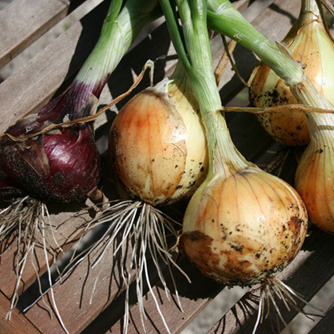
Just harvested home grown onions
As seedlings emerge what out for weeds which can smother the young plants. Mulch with sugar cane once the seedlings have grown large enough. Thin seedlings if any are closer than 10cm to each other.
If sowing by seed sounds too tricky then simply buy some seedling punnets. Gently tease apart the seedlings and plant direct into the garden bed. Spread a thin layer of sugar cane mulch around the seedlings and water in with OCP eco-seaweed to reduce the transplant shock.
Sowing Guide for Onions
| Growing Zone | Sowing Time |
| Cool Zones | Autumn, Winter, Spring |
| Mediterranean Zones | Autumn, Winter |
| Warm & Temperate Frost Free Zones | Autumn, Winter |
| Subtropical Zones | Autumn |
Tropical Zones – onions are not recommended for the tropics.
This is a general guide so always check the instructions on your seed packet to ensure the onion variety chosen is suitable for your climate and the time of planting.
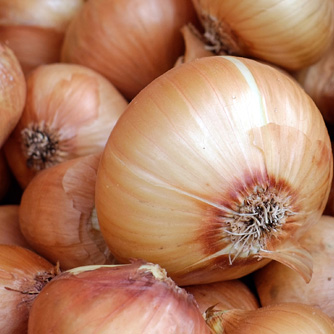
The popular brown onion stores well
Maintenance and Harvesting Onions
Onions take a good 6-8 months to mature and should be kept well watered during this time for better bulb formation. Growth can be enhanced with applications of OCP eco-seaweed and OCP eco-aminogro every 2-4 weeks. You can also dig up onions early and use the stem and leaves to flavour dishes.
Onions will be ready to harvest when the bulb has filled out and the tops brown and wilt. Gently dig them up during fine weather and place in a warm area to dry out until the outside layer turns papery. Then tidy up the bulbs by removing the shrivelled tops and roots. Onions should be stored in cool dry conditions with good air circulation.
Pest and Diseases of Onions
There are a few problems that can develop with onions:-
- Poor bulb formation (cause #1) – sowing at the wrong time of year for the variety of onion will result in poor bulb formation or the plant going to flower. Also check the seed packet to make sure you have chosen the right variety for your climate and conditions.
- Poor bulb formation (cause #2) – too much nitrogen can encourage excess green growth at the expense of bulb development. Avoid using fresh manures or high nitrogen based fertilisers.
- Poor seed germination – overwatering before seedlings emerge will result in the seed rotting. Soil needs to be kept just moist but not wet.
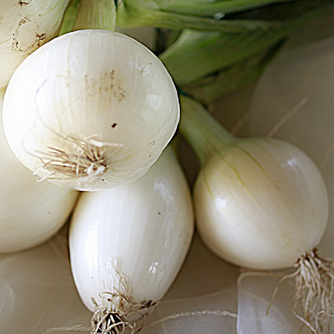
White onions need to be used soon after harvest
- Fungal issues – there are several fungi which can cause foliage damage and rotting of bulbs. They can be difficult fix once present so be proactive to avoid the problem. Practice crop rotation and test the soil pH before planting. If too acidic correct with lime or dolomite. Don’t apply high nitrogen fertilisers. Ensure onions have sufficient growing space between each plant to allow for good air flow. If problems still occur you may be overwatering.
- Sap sucking pests eg thrips and aphids – spray with an organic insecticide and use OCP Slasher to keep weeds under control as these can be breeding grounds for pests. Regular applications of OCP eco-seaweed and OCP eco-aminogro will help produce strong, healthy growth that is less vulnerable to pests.
- Seedling death – wilting and death of seedlings could be due to onion flies. The onion fly lays eggs into fresh organic matter and the hatching maggots can then attack seedlings. Avoid the problem by adding compost and manures a few weeks before planting or add later once plants are well established.
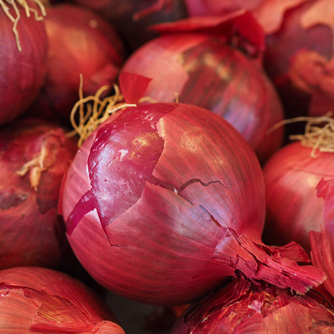
Red or spanish onions with their milder flavour


